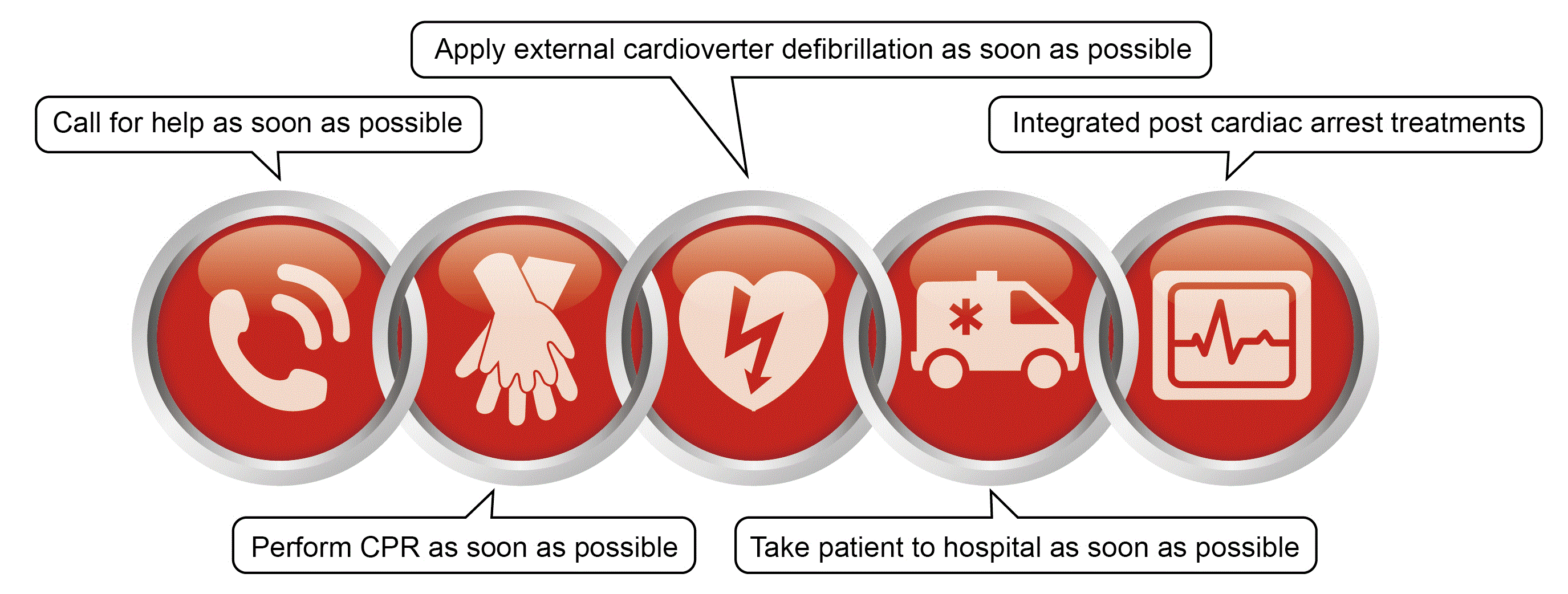| The Macau Red Cross hopes for popularizing the aim ˇ§to save others as well as ourselvesˇ¨ |

The five-step Survival Chain of saving an adult with cardiac arrest
The Red Cross First-aiders executed CPR to save a girl from imminent danger to live.
(Macau Daily News) A high school student fainted after completing a race at the schoolˇ¦s athletic games, where Red Cross and school first aiders were stationed. They found the student lost both respiration and heart functions. The on-site Red Cross first-aiders immediately conducted cardiopulmonary resuscitation (CPR) until the hospital medical staff took over the critical moment of salvaging her life. In this particular incident, Wong Ka Keong, a Red Cross first-aid mentor, rather than a medical practitioner, was directly involved in the emergency operation. He pointed out that cardiac and respiratory arrest might occur at anytime and anywhere, and if more people received proper first-aid training and were able to perform on-site CPR, they could salvage a lot of lives.
A high school student fainted after completing a race at the schoolˇ¦s athletic games, where Red Cross and school first aiders were stationed. They found the student lost both respiration and heart functions. The on-site Red Cross first-aiders immediately conducted cardiopulmonary resuscitation (CPR), provided with highly concentrated oxygen, and connected her to an automatic external cardioverter defibrillator.
Pre-hospital care as a key link
In the ambulance en-route to hospital, the patient received uninterrupted CPR until the hospital medical staff took over the critical moment of salvaging her life. After a 30-hour long comprehensive process, the patient restored consciousness, with spontaneous breathing and normal heartbeat, and she eventually revived. The miracle of saving the patient would not happen without professionalism of the medical personnel, who executed their profound experience and skill, paired with on-site CPR carried out by the Red Cross first-aiders, who maintained patientˇ¦s blood circulation, to stabilize normal oxygen supply on her brain cells. All these complicated procedures completed the successful resuscitation and rehabilitation.
It is known that brain hypoxia for over five minutes would trigger permanent brain damage, and even brain death. CPR is one of the paramount first-aid components, and a suitable application to patients with respiratory or cardiac arrest. While waiting for transporting the patient to hospital, first-aiders would usually maintain blood flow in patientˇ¦s brain manually, so as to protect normal function of the important organs.
Acute cardiac arrest mortality is extremely high. In a critical life and death moment, many immediate and direct rescues miraculously come from people accidentally to be around the patient. In this particular incident, Wong Ka Keong, a Red Cross first-aid mentor, rather than a medical practitioner, was directly involved in the emergency operation. He pointed out that cardiac and respiratory arrest mightˇ@occur at anytime and anywhere, and if more people received proper first-aid training and were able to perform on-site CPR, they could salvage a lot of lives. At any rate, if we are able to master the first-aid skill, then we can definitely save others as well as ourselves.
Master the five-step Survival Chain
The rate of saving an adult with cardiac arrest depends greatly on precise application of the five-stepˇ@Survival Chain (refer to chart above ). If all the rings are tightly linked, patientˇ¦s survival will be greatly increased. On September 30, 2017, a Macau Red Cross first-aider, stationed at the Macau International Airport, performed a CPR on a traveler who had abrupt respiratory and cardiac arrest. Ambulance of the Fire Service Bureau then took the patient to the hospital, and he survived by treatments provided by the medical staff.
|


























